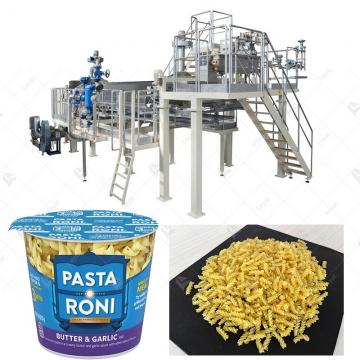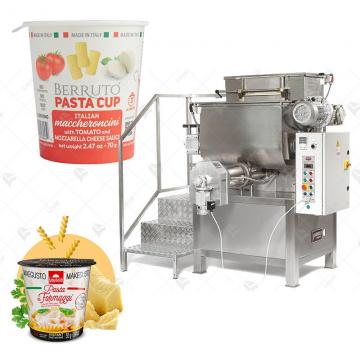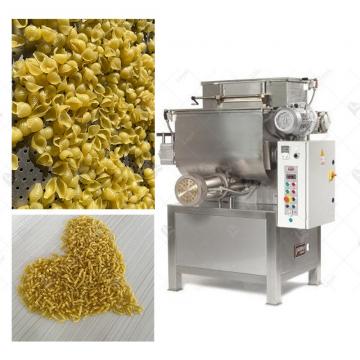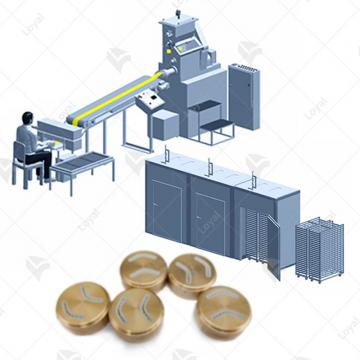
- Shandong Loyal Industrial Co.,Ltd.
- SHORT-CUT PASTA PRODUCTION LINE LONG-CUT PASTA PRODUCTION LINE INSTANT PASTA PRODUCTION LINE
Home> Company News> The Ultimate Guide to Long-cut Pasta Production Line in 2024

The Ultimate Guide to Long-cut Pasta Production Line in 2024
2024-03-28 11:37:34Long-cut pasta, a beloved staple in many cuisines worldwide, comes in various shapes and sizes, each serving a unique purpose in culinary creations. From the iconic spaghetti to the versatile fettuccine, long-cut pasta offers a wide range of options for chefs and home cooks alike. In this article, we'll explore the production process of long-cut pasta and the equipment involved, focusing on the intricacies of spaghetti and other popular varieties.
The production of long-cut pasta, including spaghetti, involves specialized machinery designed to handle the intricate process efficiently. A spaghetti pasta production line typically consists of several key components, such as mixers, extruders, cutters, dryers, and packaging machines. These machines work in tandem to transform raw ingredients into the familiar strands of pasta that grace dinner tables around the world.
In addition to spaghetti, the long-cut pasta production line can accommodate other popular varieties, including linguine, fettuccine, and tagliatelle. Each type of pasta requires specific adjustments to the production equipment to ensure optimal results in terms of texture and shape. Manufacturers invest in versatile pasta processing equipment capable of producing a diverse range of long-cut pasta shapes to meet consumer demand.
Benefits of Long-Cut Pasta Production Lines
1. High Efficiency: Long-cut pasta production lines are designed for high-speed operation, allowing manufacturers to meet demand efficiently and reduce production costs.
2. Consistent Quality: The automated nature of these production lines ensures uniformity in pasta shape, size, and texture, resulting in consistent quality across batches.
3. Versatility: Long-cut pasta production lines can be easily configured to produce a wide range of pasta shapes and sizes, providing manufacturers with flexibility to cater to diverse consumer preferences.
4. Labor Savings: By automating various stages of the pasta production process, these lines reduce the need for manual labor, thereby lowering labor costs and minimizing the risk of human error.
Key Components of a Long-Cut Pasta Production Line
1. Dough Preparation: The process begins with the mixing of durum wheat semolina flour and water to form a consistent dough. This dough is then kneaded to develop the gluten structure required for pasta elasticity.
2. Extrusion: The prepared dough is fed into an extruder, which shapes the pasta into long strands of desired thickness. The extruder utilizes specialized dies to produce various shapes and sizes of long-cut pasta.
3. Drying: The freshly extruded pasta undergoes a drying process to remove excess moisture and stabilize its shape. This step is crucial for preventing the pasta from sticking together during storage and cooking.
4. Cutting and Sorting: Once dried, the pasta strands are cut into uniform lengths using precision cutting machines. These machines ensure consistency in the length of the final product. The cut pasta is then sorted and inspected to remove any defective pieces.
5. Packaging: The sorted pasta is packaged into bags or boxes according to predetermined weights and quantities. Automated packaging equipment ensures efficient and hygienic packaging of the final product.
Routine Maintenance of Long-Cut Pasta Production Line
Spaghetti pasta production line and long-cut pasta production line are complex systems comprised of various components such as mixers, extruders, dryers, and packaging machinery. Each component plays a vital role in the pasta-making process, and regular upkeep is necessary to prevent malfunctions.
1.Cleaning:One of the primary maintenance tasks is cleaning. Over time, pasta processing equipment can accumulate residue from flour, dough, and other ingredients. This buildup can impair the equipment's performance and compromise food safety. Regular cleaning of all components, including conveyor belts, hoppers, and dies, is essential to remove any debris and ensure hygienic production.
2.Lubrication:In addition to cleaning, lubrication is another critical aspect of maintenance. Moving parts such as gears, bearings, and chains require adequate lubrication to reduce friction and prevent wear and tear. Lubricants should be applied according to the manufacturer's recommendations to avoid over-lubrication, which can attract dust and contaminants.
3.Wear and Tear:Inspecting the equipment for wear and tear is also essential. Replace any damaged or worn-out parts promptly to prevent them from causing further damage or compromising product quality. This includes checking belts, seals, and cutting blades for signs of deterioration and replacing them as needed.
4.Calibration:Furthermore, calibration of the equipment is necessary to ensure accurate processing and consistent product quality. Temperature sensors, pressure gauges, and other monitoring devices should be calibrated regularly to maintain optimal performance.
5.Tightening:Another crucial aspect of maintenance is tightening. Vibrations and constant use can cause bolts and fasteners to become loose over time. Regularly inspecting and tightening these connections helps prevent equipment malfunction and ensures safety in the production environment.
6.Staff Training :training staff on proper operation and maintenance procedures is essential for the long-term performance of the production line. Educated operators are better equipped to identify issues early, perform routine maintenance tasks, and operate the equipment safely and efficiently.
Long-cut Pasta Production Line Equipment Operating Procedures
Operating a spaghetti process line or pasta processing equipment in a pasta factory machine requires adherence to specific procedures to ensure efficiency and product quality. Below are the detailed operating procedures for long-cut pasta production line equipment:
1. Preparation and Setup:
Before starting the production line, ensure that all equipment, including mixers, extruders, dryers, and packaging machines, are clean and in working condition. Check the raw materials, such as semolina flour and water, for quality and quantity.
2. Mixing:
The first step in the production process is mixing the ingredients to form the pasta dough. Measure the required amounts of semolina flour and water according to the recipe. Use a mixer to combine the ingredients thoroughly until a homogeneous dough is formed.
3. Extrusion:
Once the dough is ready, it is fed into the extruder, where it is forced through a die to give it the desired shape, such as spaghetti or fettuccine. Adjust the settings on the extruder to control the thickness and length of the pasta.
4. Cutting and Shaping:
After extrusion, the pasta is cut into long strands using sharp blades or knives. The cut pasta is then shaped into uniform lengths and sizes, ready for the drying process.
5. Drying:
The cut pasta is transferred to a drying chamber, where it is exposed to controlled temperatures and humidity levels. This process removes moisture from the pasta, making it shelf-stable and preventing spoilage. Monitor the drying process closely to ensure that the pasta reaches the desired moisture content.
6. Quality Control:
Throughout the production process, conduct regular quality checks to ensure that the pasta meets the required standards for texture, color, and taste. Inspect the raw materials, intermediate products, and finished pasta for any defects or irregularities.
7. Packaging:
Once the pasta has been dried and inspected, it is ready for packaging. Use packaging machines to weigh and seal the pasta into bags or boxes according to the customer's specifications. Label each package with the appropriate information, including the product name, weight, and expiration date.
8. Cleaning and Maintenance:
After the production run is complete, thoroughly clean all equipment and work surfaces to prevent cross-contamination between batches. Perform routine maintenance on the machinery to keep it in optimal condition and minimize downtime.
Advanced Technologies and Innovations in Long-cut Pasta Production
In the realm of pasta production, advancements in technology have revolutionized the way long-cut pasta is manufactured. The introduction of spaghetti process lines and state-of-the-art pasta processing equipment has significantly enhanced efficiency, quality, and output in pasta factories worldwide.
One of the key innovations in long-cut pasta production is the development of spaghetti process lines. These sophisticated systems are designed to streamline the entire production process, from dough preparation to packaging. By integrating automation and advanced control systems, spaghetti process lines can precisely monitor and adjust parameters such as dough consistency, extrusion speed, and drying temperature, ensuring consistent quality and uniformity in the final product.
Moreover, modern pasta processing equipment plays a crucial role in optimizing production efficiency and reducing operational costs. High-capacity mixers, extruders, and drying tunnels equipped with advanced technologies enable pasta manufacturers to increase throughput while maintaining strict quality standards. For example, precision extrusion systems can produce long-cut pasta with precise dimensions and uniform texture, while energy-efficient drying tunnels minimize energy consumption and reduce environmental impact.
In addition to enhancing efficiency and quality, technological innovations in long-cut pasta production also offer opportunities for product diversification and customization. With versatile pasta factory machines, manufacturers can easily adjust processing parameters to create various shapes, sizes, and flavors of long-cut pasta to cater to evolving consumer preferences and market trends. Whether it's traditional spaghetti, fettuccine, or innovative artisanal pasta shapes, modern production lines are capable of delivering a wide range of products to meet diverse demands.
Furthermore, the integration of smart sensors, data analytics, and automation technologies has enabled real-time monitoring and optimization of the entire production process. By collecting and analyzing data on key performance indicators such as production yield, energy consumption, and product quality, manufacturers can identify areas for improvement and implement proactive measures to enhance overall efficiency and competitiveness.
Challenges and Solutions in Long-cut Pasta Production
Long-cut pasta production poses several challenges that manufacturers must address to maintain consistent quality, address environmental concerns, ensure food safety standards, and manage production costs effectively.
Maintaining Consistent Quality
One of the primary challenges in long-cut pasta production is maintaining consistent quality throughout the manufacturing process. With the use of electric pasta machines and automatic pasta making machines, ensuring uniformity in shape, size, and texture becomes crucial. Variations in these factors can affect the overall quality of the pasta and customer satisfaction.
Solution: Implementing advanced technology such as spaghetti production lines and long-cut pasta production lines can help maintain consistent quality by automating the manufacturing process. These production lines are equipped with sensors and monitoring systems that detect any deviations from the desired specifications, allowing for immediate adjustments to ensure uniformity.
Addressing Environmental Concerns
Long-cut pasta production can have environmental implications, particularly in terms of energy consumption, water usage, and waste generation. Traditional manufacturing methods may contribute to carbon emissions and resource depletion if not managed efficiently.
Solution: Investing in sustainable practices and technology can mitigate the environmental impact of pasta production. For example, manufacturers can adopt energy-efficient electric pasta machines and implement water recycling systems to reduce consumption. Additionally, using biodegradable packaging materials and implementing waste reduction strategies can further minimize the environmental footprint of the manufacturing process.
Ensuring Food Safety Standards
Maintaining food safety standards is paramount in long-cut pasta production to prevent contamination and ensure consumer health. Factors such as proper hygiene practices, ingredient quality, and sanitation procedures play a crucial role in upholding these standards.
Solution: Implementing stringent quality control measures and adhering to regulatory guidelines can help ensure food safety throughout the production process. Regular inspections, thorough cleaning protocols, and employee training on hygiene practices are essential components of a comprehensive food safety program. Additionally, investing in state-of-the-art automatic pasta making machines equipped with sanitary design features can further minimize the risk of contamination.
Managing Production Costs
Balancing cost-effectiveness with quality and efficiency is a constant challenge for pasta manufacturers. Rising ingredient prices, energy costs, and labor expenses can put pressure on profit margins if not managed effectively.
Solution: Adopting lean manufacturing principles and optimizing production processes can help reduce costs without compromising quality. Investing in automation technology, such as spaghetti production lines and long-cut pasta production lines, can streamline operations and improve efficiency. Additionally, negotiating favorable contracts with suppliers, optimizing raw material usage, and implementing waste reduction initiatives can further contribute to cost savings.
Choosing The Right Machinery of Long-cut Pasta Production Line
When it comes to setting up a long-cut pasta production line, selecting the right machinery is crucial for ensuring efficiency and quality throughout the manufacturing process. One of the key considerations in choosing the machinery is its reliability and durability, as these factors directly impact the overall productivity and longevity of the production line. Companies like Loyal, renowned for their commitment to excellence and innovation in the food processing industry, offer a wide range of machinery options tailored specifically for long-cut pasta production. From extruders and mixers to drying and packaging equipment, Loyal provides comprehensive solutions designed to meet the unique needs and requirements of pasta manufacturers.
|
Long-cut Pasta Production Line Parameter |
|||
|
Item |
Capacity |
Power |
Size |
|
LYL-100 |
100kg/h |
12kw |
1200*800*1500mm |
|
LYL-200 |
200kg/h |
22kw |
1500*1000*1800mm |
|
LYL-300 |
300kg/h |
30kw |
2300*3000*4200mm |
|
LYL-500 |
500kg/h |
65kw |
3000*3000*4200mm |
|
LYL-1000 |
1000kg/h |
75kw |
4500*4000*5200mm |
Future Trends and Outlook for Long-cut Pasta Production
The future of long-cut pasta production holds exciting prospects as technology continues to evolve and shape the industry. One significant trend that is expected to dominate the landscape is the advancement in long-cut pasta production line technology. These innovative production lines are poised to revolutionize the way long-cut pasta is manufactured, offering increased efficiency and precision in every step of the process, from mixing and extrusion to drying and packaging.With the integration of cutting-edge machinery and automation, long-cut pasta production lines enable manufacturers to streamline operations, reduce production costs, and meet the growing demand for pasta worldwide. By leveraging state-of-the-art equipment and software, companies can achieve higher yields, ensure consistent quality, and adapt to changing consumer preferences with ease.
Moreover, the adoption of sustainable practices and environmentally friendly solutions is another key aspect of the future outlook for long-cut pasta production. As consumers become more conscious of the environmental impact of their food choices, manufacturers are increasingly focused on implementing eco-friendly initiatives throughout the production process. From energy-efficient machinery to biodegradable packaging materials, sustainability is driving innovation and shaping the future of long-cut pasta production.
Integration of AI and Robotics
The integration of AI and robotics has revolutionized the pasta manufacturing process, leading to the development of more efficient and precise machines. The electric pasta machine equipped with AI technology can monitor and adjust various parameters such as dough consistency, extrusion speed, and cutting length in real-time, ensuring consistent quality and reducing waste.Moreover, robotics plays a crucial role in automating repetitive tasks in the automatic pasta making machine. With robotic arms handling tasks such as dough kneading, shaping, and packaging, manufacturers can achieve higher productivity and lower labor costs. This integration not only enhances efficiency but also improves food safety by minimizing human intervention.
Customization and Personalization
As consumer preferences become more diverse, there is a growing demand for customized pasta products. Manufacturers are increasingly investing in advanced spaghetti production line and long-cut pasta production line that offer flexibility in shapes, sizes, and ingredients. With the help of AI algorithms, these machines can analyze market trends and consumer data to develop tailor-made pasta recipes to meet individual preferences.
Furthermore, the use of 3D printing technology in pasta production allows for greater personalization, enabling consumers to create their unique pasta shapes at home. This trend towards customization and personalization not only enhances consumer satisfaction but also opens up new opportunities for product innovation and brand differentiation.
Market Expansion Strategies
To capitalize on the growing demand for pasta products, manufacturers are adopting pasta factory machine with modular designs that can easily scale production capacity. This flexibility allows them to adapt to changing market dynamics and explore new geographical markets.Additionally, strategic partnerships and collaborations with food service providers and e-commerce platforms enable manufacturers to reach a wider audience and penetrate untapped markets. By leveraging digital marketing channels and data analytics, companies can identify emerging trends and consumer preferences to tailor their products and marketing strategies accordingly.
Sustainable Packaging Solutions
With increasing concerns over environmental sustainability, there is a growing emphasis on sustainable packaging solutions in the pasta industry. Manufacturers are investing in eco-friendly materials such as biodegradable plastics, compostable packaging, and recyclable materials to reduce their carbon footprint.
Furthermore, innovative packaging designs, such as portion-controlled packs and resealable pouches, help minimize food waste and extend shelf life. By adopting sustainable packaging solutions, manufacturers not only contribute to environmental conservation but also enhance brand reputation and appeal to eco-conscious consumers.
Importance of Quality Control In Long-cut Pasta Production Line
Quality control plays a pivotal role in the long-cut pasta production line to ensure consistency and excellence in the final product. From the selection of premium-grade durum wheat to the extrusion and drying processes, every stage requires meticulous attention to detail. Implementing stringent quality control measures not only guarantees the uniformity of texture and taste but also enhances the overall consumer experience. Similarly, in the spaghetti pasta production line, adherence to quality control standards is paramount to delivering spaghetti strands that are perfectly al dente and free from defects. By monitoring parameters such as moisture content, protein levels, and extrusion pressure, manufacturers can uphold the highest standards of quality and uphold the reputation of their brands. In essence, quality control serves as the cornerstone of excellence in both long-cut and spaghetti pasta production lines, ensuring that every bite delights the palate of consumers worldwide.
References
1. Food Engineering Magazine
Website:https://www.foodengineeringmag.com/
2. Food Manufacturing Magazine
Website:https://www.foodmanufacturing.com/
3. Food Processing Magazine
Website:https://www.foodprocessing.com/
4. Institute of Food Technologists (IFT)
Website:https://www.ift.org/
5. European Food Safety Authority (EFSA)
Website:https://www.efsa.europa.eu/
Frequently Asked Questions about Long-Cut Pasta Production Line
1. What is a long-cut pasta production line?
A long-cut pasta production line is a sophisticated system designed for the mass production of various types of long-cut pasta, such as spaghetti, fettuccine, and linguine. It typically consists of several key components, including dough mixing equipment, extruders, cutters, dryers, and packaging machinery. These lines are engineered to ensure efficiency, consistency, and high-quality output.
2. How does a long-cut pasta production line work?
The process begins with the mixing of durum wheat flour and water to form a dough. This dough is then fed into an extruder, where it is forced through a die to create the desired pasta shape, whether it be spaghetti or another long-cut variety. The formed pasta is then cut to the appropriate length, dried to remove excess moisture, and finally packaged for distribution.
3. What are the key considerations in operating a long-cut pasta production line?
Maintaining consistent dough consistency, proper extrusion parameters, and precise drying conditions are critical factors in ensuring the quality of the final product. Additionally, sanitation and hygiene practices must be rigorously upheld to comply with food safety standards and regulations.
4. Can a long-cut pasta production line accommodate different pasta shapes?
Yes, modern long-cut pasta production lines are often equipped with interchangeable dies and cutters, allowing for the production of various pasta shapes on the same line. This versatility enables manufacturers to meet the diverse demands of consumers and adapt to changing market trends effectively.
5. How does a spaghetti pasta production line differ from a long-cut pasta production line?
While both types of production lines share similar components and processes, a spaghetti pasta production line is specifically optimized for the manufacture of spaghetti and other thin, cylindrical pasta shapes. The extrusion dies and cutters are designed to produce these specific shapes with precision, ensuring uniformity and consistency in the final product.
 Instant Pasta Production Line
Instant Pasta Production Line INSTANT PASTA CUP PRODUCTION LINE
INSTANT PASTA CUP PRODUCTION LINE PRECOOKED PASTA PRODUCTION LINE
PRECOOKED PASTA PRODUCTION LINE Dry Pasta Production Line
Dry Pasta Production Line